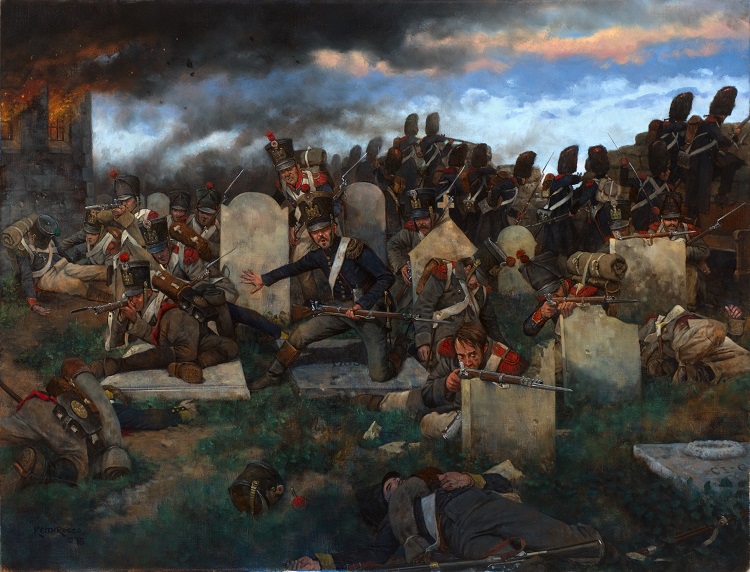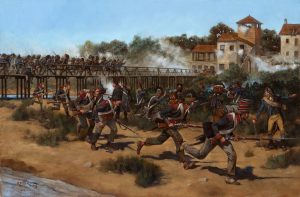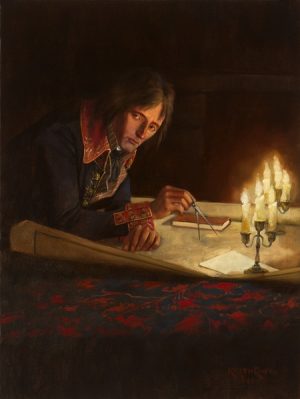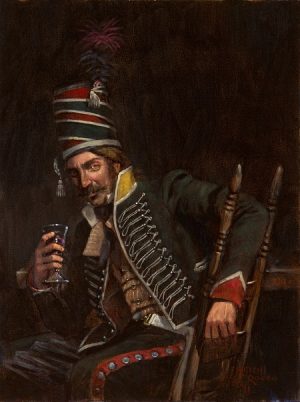Plancenoit
Description
50 signed and numbered prints
The Cemetery of St. Catherine’s Church at Plancenoit, June 18, 1815
The peaceful and humble village of Plancenoit met with a violent destiny on the afternoon of June 18, 1815, when it became the focal point of Prussian attacks on the right rear of Emperor Napoleon’s Armée du Nord.
As the French concentrated most of their forces against the British Duke of Wellington’s Anglo-Dutch Army blocking the road to Brussels, masses of Prussian troops under Field Marshal Gebhard von Blücher began to appear from the woods to the east of the village. Rushing battalions of Imperial Guard units from his reserve to Plancenoit, Napoleon sensed that the small town could become the key to victory or defeat for his army.
The battle for the village swung back and forth between French and Prussian control. Each time the Prussians surged into the village a fresh but woefully small force of the French Imperial Guard would retake the streets and buildings.
In the center of the village, rising like a medieval chateau, stood the stone church of Saint Catherine, surrounded by a stone wall over six feet tall which encompassed the cemetery. On this elevated stage would play out the sanguinary fight that would decide the fate of Napoleon’s Army at Waterloo.
Plancenoit was the scene of bitter close action fighting, often hand-to-hand, what was perhaps the most furious fighting during the Battle of Waterloo and also the most difficult to describe as the memoirs that exist are few. It is clear though that the first French forces sent to hold the town were battalions of the Young Guard, Voltigeurs and Tirailleurs. As Prussian pressure mounted and French casualties climbed, Napoleon sent in battalions of the Old Guard from his remaining reserves, men from the Chasseur and Grenadier regiments. Napoleon’s grognards (“grumblers”) retook Plancenoit at the point of the bayonet.
A Prussian officer who took part in the attacks at Plancenoit left a vivid description of the action inside the cemetery walls during one of the brief Prussian occupations of the site:
“Oberst Hiller von Gaertringen now tried to entrench the churchyard, but the walls were too high to fire over them and too solid to cut loopholes through them, and so the Prussian troops entered the church and ripped out the benches in order to create platforms in rear of the churchyard wall and to bar the entrances; they also attempted to pull down the top of the wall….”
As the situation became more and more desperate for the French, the last elements still fighting made a stand in the walled cemetery of St. Catherine’s Church.
The painting by Keith Rocco depicts these final moments of the French defense of the cemetery. In the foreground lie the dead and wounded from both sides. Just behind these bodies and among the tombstones a remnant of the Young Guard 3rd Regiment of Tirailleurs waits to deliver a volley. At their center a lieutenant has picked up a musket to add another ball to the group’s fire. He signals them to hold their fire until the last moment. One can sense the presence of the Prussians, behind the viewer, as they approach the entrance and the west wall of the cemetery.
Behind this group, manning the stone wall, are soldiers of the Old Guard—clearly identifiable, even through the failing light of dusk and the smoke, by their bearskin bonnets. At the extreme right of the painting, men stand on the pews first used by the Prussians to fire over the wall. In the rear center of the painting, other French soldats defend an area of the wall either successfully torn down to fire over or knocked down by artillery battering.
A casualty of the Voltigeurs of the Young Guard lies propped against the stone wall of the burning church, a silent witness to an earlier occupation of St. Catherine’s by the French.
“But the interior of the church presented a spectacle more savage and more terrible still,” Prussian General von Pirch would later relate, “that the waves of light from the billowing flames which crossed the windows, enlightened the dead and the disfigured features of the wounded and of the dying, who crowded the sacred edifice.”
Shortly after, French resistance in Plancenoit was overwhelmed and those who could melted away in the increasing darkness to join the retreating French army.
Additional information
| Medium | |
|---|---|
| Size | 20" x 26", 14" x 18" |
| Type |





